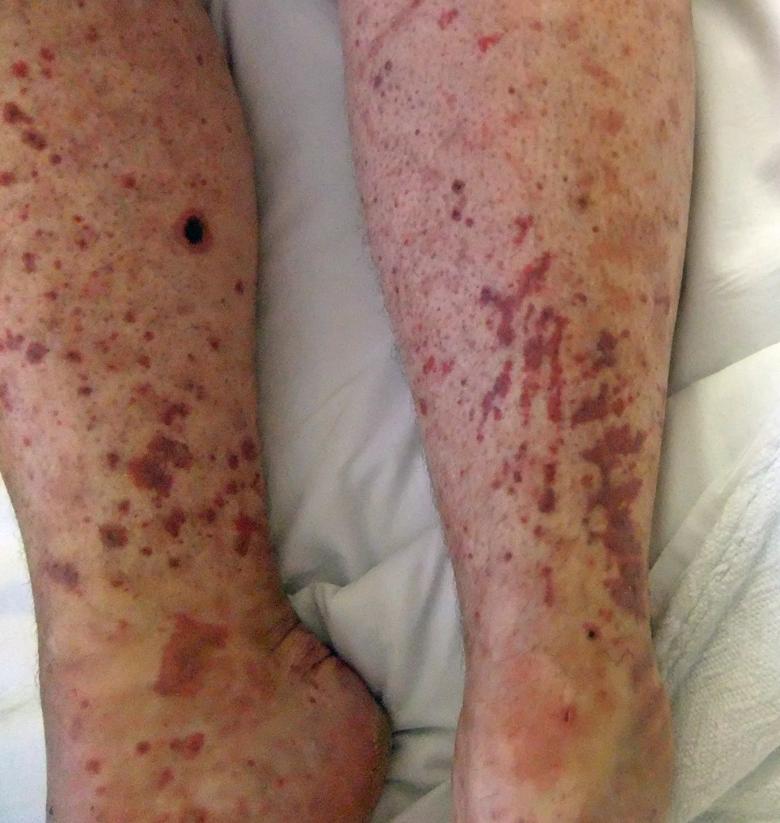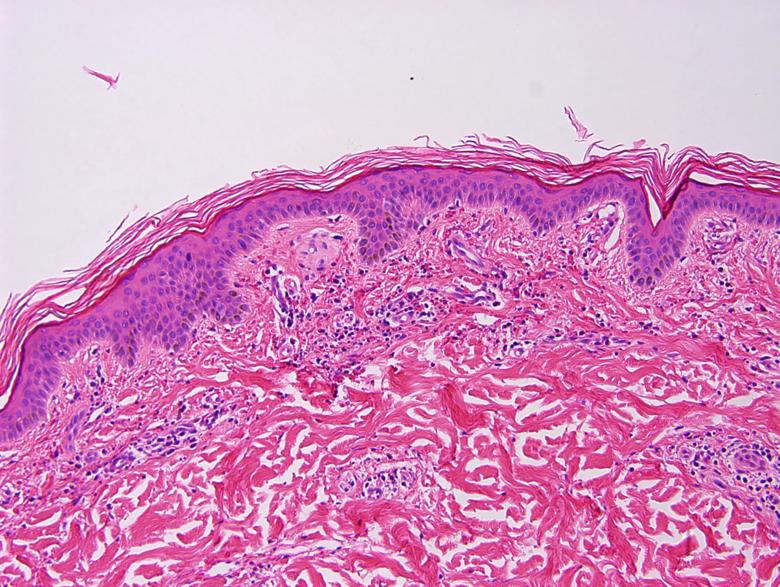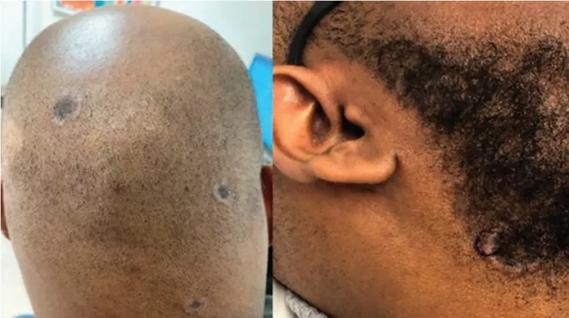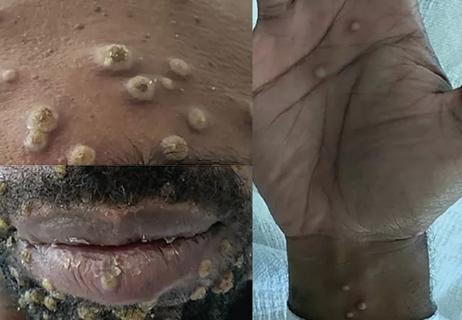Key aspects in focusing the assessment
By Carol A. Langford, MD, MHS, and Anthony P. Fernandez, MD, PhD
Cleveland Clinic is a non-profit academic medical center. Advertising on our site helps support our mission. We do not endorse non-Cleveland Clinic products or services. Policy
A 42-year-old female presents with a three-week history of a purpuric rash. On examination, numerous 2-3 mm non-blanching erythematous skin lesions are present on her bilateral lower extremities. She states that individual lesions resolve after four to five days, but new lesions continue to appear. You are suspicious that she has a cutaneous vasculitis. What should be the next steps in your assessment?

Coalescing purpuric lesions involving the lower extremities in a patient with cutaneous vasculitis.
Cutaneous vasculitis is the most common vasculitic manifestation encountered in clinical practice. Although this frequently manifests as palpable purpura, it can have a wide range of appearances. In over 70 percent of patients, cutaneous vasculitis will be due to a medication, infection, malignancy, an underlying inflammatory disease or a primary systemic vasculitis. In the remaining 30 percent, this presents as an isolated cutaneous vasculitis in which no other organs are affected and there is no evidence of a linked cause.
When a cutaneous vasculitis is suspected, assessment should focus on three goals: 1) rule out vasculitis that is threatening a critical organ; 2) confirm that this is vasculitis; 3) identify an underlying trigger or disease where possible.
Detection of organ-threatening vasculitis is based on information from the history, physical examination, labs and imaging. Although most vasculitic involvement of most organ sites will have associated symptoms or signs, these may not be present with lung or kidney involvement. In the case of pulmonary vasculitis, up to 30 percent of patients can have radiographic abnormalities despite the absence of other clinical features. With renal vasculitis, the patient may look and feel well and yet have active glomerulonephritis that places them at risk of renal failure.
The medical history can provide clues regarding affected organ sites, a trigger or an underlying disease. The medication assessment should include not only newly prescribed medications, but also over-the-counter agents, supplements and recreational substances. Physical examination is important in detecting objective evidence of tissue inflammation. For locations such as the upper airways, eyes, nerve, large blood vessels or skin, examination is the primary means through which active disease is evaluated. Laboratory testing should include a complete blood count with differential, chemistries (renal and hepatic function), acute phase reactants (sedimentation rate and/or C-reactive protein) and a urinalysis. Other studies such as antineutrophil cytoplasmic antibodies (ANCA), antinuclear antibodies (ANA), cryoglobulins or blood cultures should be guided by features that suggest an associated diagnosis. Chest radiography should be obtained in all patients with cutaneous vasculitis, even in the absence of pulmonary symptoms.
A skin biopsy of lesions suspicious for vasculitis should be performed in adult patients where the diagnosis is unknown (Figure 2). Biopsy can not only confirm vascular inflammation but can rule out other etiologies that may have a similar appearance. In addition to standard histology, there should be consideration of performing immunofluorescence studies on the biopsy. IgA vasculitis (Henoch-Schönlein) is most frequently seen in children, but it can also occur in adults where the detection of IgA within compatible skin lesions can be helpful in securing the diagnosis. As immunofluorescence cannot be performed on formalin fixed tissue, this must be considered at the time the biopsy is obtained in order for the sample to be processed correctly.

Histopathology of cutaneous vasculitis demonstrating perivascular and interstitial neutrophilic infiltrates, with leukocytoclasis, and extravasated erythrocytes consistent with a leukocytoclastic vasculitis.
Once vasculitis of the skin is confirmed, therapy is directed towards the underlying cause. For patients where cutaneous vasculitis is occurring secondarily, removing the trigger or managing the underlying disease will typically address the skin vasculitis as will treating an active primary systemic vasculitis.
For isolated cutaneous vasculitis, the optimal management approach has not been established. As this is not life-threatening, the goal is to use the least toxic yet effective therapy, balancing the risks of the medication against the risks of the vasculitis and its impact on quality of life. For asymptomatic skin lesions, observation and monitoring can be an appropriate option. When the cutaneous vasculitis is symptomatic and recurrent, commonly used agents include colchicine, dapsone, hydroxychloroquine and pentoxifylline. Immunosuppressive medications such as azathioprine or methotrexate can also be considered, particularly when disease is recurrent despite non-immunosuppressive options. There is currently no good evidence suggesting one treatment is more effective than others.
Cleveland Clinic is participating in a randomized trial being conducted by the NIH-funded Vasculitis Clinical Research Consortium (VCRC) which seeks to determine the comparative efficacy of azathioprine, colchicine and dapsone in cutaneous vasculitis (ARAMIS). A concurrent study of skin biopsies seeks to better understand the pathophysiologic mechanisms occurring in vasculitis of the skin (CUTIS).
For our patient, on careful history she commented on weight loss, fatigue and new nasal congestion and epistaxis that was worsening. On examination, her nasal membranes had an ulcerated appearance. She underwent a skin biopsy that demonstrated a leukocytoclastic vasculitis that was negative for IgA. Based upon her collective features, granulomatosis with polyangiitis (GPA) was within the differential and serologic testing was performed that revealed a positive proteinase 3 ANCA with a cytoplasmic staining pattern on indirect immunofluorescence (cANCA). Urinalysis and chest radiography were normal. The patient was treated with prednisone and methotrexate on which her cutaneous and upper airways disease went into remission.
Effective diagnosis and management of patients with cutaneous vasculitis requires a multidisciplinary approach that begins with the physician to whom the patient first presents and then includes the dermatologist and rheumatologist. The keys to a successful outcome include recognition of cutaneous vasculitis and its potential systemic associations, prompt assessment to confirm the diagnosis and to rule out critical organ involvement, and consultative referrals as are clinically indicated.
At Cleveland Clinic, the collaborative relationship between dermatology and rheumatology has been essential, not only in vasculitis but across a broad range of rheumatic diseases where cutaneous features can occur. By enhancing clinical care and research, these collaborations are advancing knowledge that benefits patients.
Dr. Langford is Director of the Center for Vasculitis Research at Cleveland Clinic as well as Vice Chair for Research, Department of Rheumatic and Immunologic Diseases. Dr. Fernandez is Director of Medical Dermatology.

Consider secondary syphilis in the differential of annular lesions

Persistent rectal pain leads to diffuse pustules

Techniques are borrowed from rhinoplasty, malar augmentation and others

Two cases — both tremendously different in their level of complexity — illustrate the core principles of nasal reconstruction

Stress and immunosuppression can trigger reactivation of latent virus

Low-dose, monitored prescription therapy demonstrates success

Antioxidants, barrier-enhancing agents can improve thinning hair